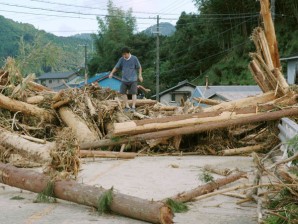Killer typhoon brings more misery to Japan
Tokyo — Japan braced for more heavy rain and floods Monday as the death toll from the worst typhoon to hit the country in seven years climbed to 34. Rescuers searched for 55 others who remained missing, and tens of thousands of families struggled without power or telephone service.

‘AFTER THE STORM. A man walks on driftwood piled up on a bridge after a powerful typhoon in Kiho, Mie Prefecture, central Japan, Monday, Sept. 5, 2011. Typhoon Talas, which was believed to be the worst to hit Japan since 2004, lashed coastal areas with destructive winds and record-setting rains over the weekend before moving offshore into the Sea of Japan. AP Photo/Kyodo News
Typhoon Talas, which was later downgraded to a tropical storm, lashed coastal areas with destructive winds and record-setting rains over the weekend before moving offshore into the Sea of Japan. Thousands were stranded as it washed out bridges, railways and roads.
The destruction added more misery to a nation still reeling from a catastrophic earthquake and tsunami six months ago. In one of his first acts in office, Prime Minister Yoshihiko Noda — sworn in just one day before Talas made landfall — vowed the government would provide as much assistance as quickly as it could.
His predecessor, Naoto Kan, was forced out in large part because of public anger over the response to the tsunami, which left nearly 21,000 people dead or missing and touched off the worst nuclear disaster since Chernobyl.
“We will do everything we can to rescue people and search for the missing,” Noda said.
The typhoon was the worst to hit Japan since 2004, when 98 people were killed or reported missing. It caused most of its damage on the Kii peninsula in central Japan southwest of Tokyo and hundreds of miles (kilometers) from the country’s tsunami-ravaged northeastern coast.
Article continues after this advertisementThe Japan Meteorological Agency predicted more heavy rain Tuesday in northern and western Japan, where the already sodden ground caused fears of more mudslides and floods.
Article continues after this advertisementThe extent of damage from the typhoon was still emerging Monday.
Rescuers and reconnaissance teams spread out over the worst-hit areas to look for survivors or people stranded in flood zones, which though far smaller in scale were reminiscent of the debris-ridden, mud-caked wasteland created by the tsunami.
Television footage showed washed-out train bridges, whole neighborhoods inundated by swollen rivers and police using rope to pull frightened survivors out of homes awash in the murky waters.
Nearly 200,000 households remained without power Monday afternoon, Kyodo reported.
During the search effort Monday, rescuers recovered a dozen more bodies, bringing the confirmed death toll to 34, according to the government’s emergency headquarters. Evacuation advisories remained in place for about 100,000 people, although the storm itself was no longer over land.
Most of the dead were in Wakayama prefecture (state), said local official Seiji Yamamoto. Twenty-two people were killed and 22 others were missing in Wakayama alone.
“There are so many roads out that it is hard to count them all,” he said. “Hundreds of homes have been flooded.”
The body of a woman found Sunday in the town of Nachikatsuura was confirmed to be the mayor’s 24-year-old daughter, who was to have held a betrothal ceremony with her fiance later that day, Kyodo reported. The mayor’s wife was also swept away and still missing.
“I have no place to sleep when I go home today. My family is not there,” it quoted Mayor Shinichi Teramoto as saying.
In the nearby prefecture of Nara, fears of more mudslides in rain-soaked areas delayed rescue efforts.
Rains and wind were recorded across wide swaths of Japan’s main island, but no significant damage was reported in the tsunami-ravaged northeast.
As the typhoon approached, evacuation orders or advisories were issued to 460,000 people. At least 3,600 people were still stranded by flooded rivers, landslides and collapsed bridges, Kyodo reported.
The center of the season’s 12th typhoon crossed the southern island of Shikoku and the central part of the main island of Honshu overnight Saturday. It then moved slowly — almost at the pace of a jogger — north across the Sea of Japan off the country’s west coast, the meteorological agency said.
Talas is a word from the Philippines that means “sharpness.”
___
Associated Press writer Mari Yamaguchi contributed to this report.